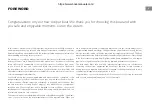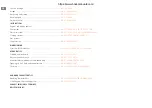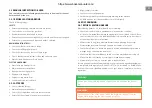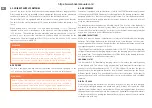
• Reduce your speed and wake as a matter of courtesy, and also for the safety of
yourself and others.
• Observe and obey speed limits and prohibitions associated with a swell.
• Follow the rules of navigation and the requirements of COLREG (Convention on
the International Regulations for Preventing Collisions at Sea).
• Always make sure that you have the space needed for avoiding collisions and
coming to a halt and for evasive manoeuvres.
• Always use a dead man’s switch if available.
• Reduce speed in high seas for increased comfort and safety.
• Learn your boat’s speed potential. Utilise this knowledge for economical and
safe cruising.
• Avoid using high speed along with large rudder movements when going astern,
because that places great strain on the rudder and steering mechanism.
• Avoid sudden steering manoeuvres at high speeds.
• Avoid staying in the bow area when driving at high speeds.
You should avoid sudden changes in direction of travel at high speed. Let the boat
come to a stop, and the engine rev down before shifting between forward and
reverse. Otherwise excessive strain is put on the engine, which could cause the
engine to stop. In the worst case, sea water may enter the engine.
A right-handed propeller rotates clockwise and a left-handed propeller
anti-clockwise, seen from the stern. The rotation of the propeller is critical for
steering the boat. The right handed propeller pushes the stern of the boat to
starboard when the engine is engaged ahead and to port when it is going astern.
The direction of rotation of the propeller has a major impact on the turning
radius. A right handed propeller gives a smaller turning radius to port than to
starboard. This is called the propeller’s paddlewheel effect.
Your propellers have considerable propulsion power that provides powerful accel-
eration. Take this into consideration to avoid dangerous situations arising from this.
DRIVING IN ROUGH SEAS
Never go out in rough seas, if you are uncertain whether the boat and those on
board can cope. Follow these simple rules:
• Be well prepared.
• Remember to secure loose equipment.
• Always have a sea-anchor and other emergency equipment easily accessible.
• Avoid breaking seas that can appear close to land and over shallows.
• If there are significant waves, always reduce speed to guarantee the safety of
the persons on board.
• Use the trim tab to trim the bow down to reduce hull slamming in a head sea.
IN A HEAD SEA
• Adjust speed to suit the size of the waves.
• Adjust the trim angle to the size of the waves. Avoid taking seas beam on.
IN A FOLLOWING SEA
• Remember to keep the bow high in a following sea.
• Avoid crashing through waves, maintain low speed.
• If necessary, deploy the sea anchor to reduce speed.
• Planing boats can be particularly exposed in rough following seas. The stern of
the boat rises and the rudder does not answer, so the boat broaches while the
bow cuts down into the sea.
MANOEUVRING IN NARROW CHANNELS
When manoeuvring the boat in narrow channels the engine speed should be kept
as low as possible so that manoeuvres are calm and steady. In difficult wind and
current conditions, more revs might be necessary to make full use of the power of
the engine. In these conditions, it is important that manoeuvres are made quickly
and precisely to pre- vent the boat from drifting into trouble for example.
19
https://www.boat-manuals.com/
Summary of Contents for 24 HT 2016
Page 1: ...AXOPAR 24 HT OWNER S MANUAL https www boat manuals com ...
Page 2: ...https www boat manuals com ...
Page 3: ...3 https www boat manuals com ...
Page 35: ...9 3 FUEL SYSTEM FOR NORTH AMERICAN REGION 35 https www boat manuals com ...
Page 36: ...https www boat manuals com ...
Page 37: ...37 https www boat manuals com ...
Page 38: ...38 https www boat manuals com ...
Page 39: ...39 https www boat manuals com ...
















































